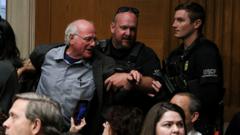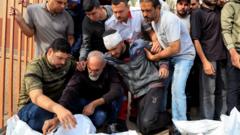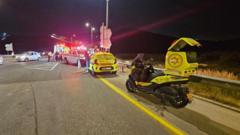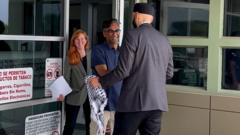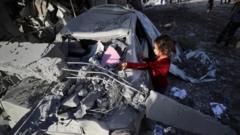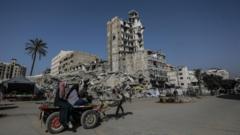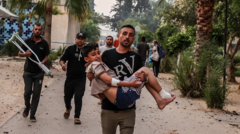The Israeli government is building aid hubs in Gaza in a plan met with backlash from the UN, which warns the blockade has created a severe humanitarian crisis. Humanitarian agencies are skeptical of the new system, fearing it may cut off assistance to those most in need.
New Humanitarian Aid Hubs Under Construction in Gaza Amid Controversy
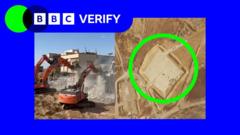
New Humanitarian Aid Hubs Under Construction in Gaza Amid Controversy
Satellite images reveal Israeli efforts to establish humanitarian aid distribution centres in Gaza, despite widespread criticism from the UN and humanitarian organizations.
Israeli authorities are making strides in constructing several humanitarian aid distribution centres in Gaza, as shown by recent satellite images. This initiative comes amidst a contentious backdrop, with the United Nations and various leaders criticizing Israel's decision to halt food and medicine deliveries to the region back in March. Officials claim this suspension aims to pressure Hamas into releasing remaining hostages, while also accusing the group of misappropriating aid—claims that Hamas has denied.
As a result of the ongoing blockade, a UN report has warned that Gaza’s 2.1 million residents are facing severe food, medical, and fuel shortages, putting them at a "critical risk" of famine. Last week, the US announced plans to set up a new aid distribution system within Gaza, overseen by private companies and secured by Israeli military personnel and contractors.
Recent analysis by BBC Verify shows that land has been cleared for these planned aid hubs, with new roads and logistical areas developed in southern and central Gaza over the past weeks. While Israeli officials have not disclosed the exact locations, humanitarian sources suggest at least four hubs will be constructed in southern Gaza, with another north near the Netzarim Corridor, an area controlled by Israeli military forces.
The Gaza Humanitarian Foundation indicated that the centers are aimed at supplying essentials such as food, water, and hygiene kits to 1.2 million individuals—less than 60% of Gaza's population. However, operations are expected to commence only before the end of May, and calls have emerged from the foundation for expedited aid delivery through traditional channels until these new centres are operational. Criticism has also arisen regarding the exclusion of northern Gaza from the original distribution plans, creating fears of forced relocations.
UN organizations have rejected the proposed plan, emphasizing that it contradicts fundamental humanitarian principles. A spokesperson for the UN’s Office for the Coordination of Humanitarian Affairs, Olga Cherevko, stated that the strategy of channeling aid through a limited number of militarized hubs would effectively isolate the most vulnerable populations unable to relocate easily for assistance.
In response to the criticisms, Bushra Khalidi from Oxfam expressed that the plan serves as a "farce," arguing that no logistical arrangement can counteract Israel's use of starvation as a means of war. She called on authorities to lift the siege and restore open crossings for aid.
BBC Verify identified several potential sites for these distribution centres utilizing satellite imagery. The identified locations appear similar to existing distribution hubs such as Erez and Kerem Shalom, with one site in southwest Gaza showing significant development. Recent photos capture heavy machinery actively working on these locations, showcasing a growing infrastructure that raises concerns about military control over aid.
Analysts affirm that these facilities are likely intended to be secured distribution centres, strategically positioned near IDF Forward Operating Bases, allowing the Israeli military significant oversight of operations. The military has not officially commented on these developments, and the government agency overseeing crossings into Gaza, Cogat, did not respond to further inquiries.
Despite Israel's insistence that aid levels remain adequate in Gaza and their compliance with international law, the blockade continues to evoke fervent arguments over humanitarian rights and the well-being of Gaza’s beleaguered population.


